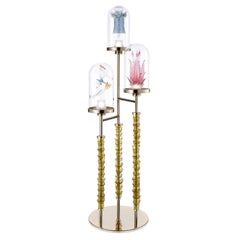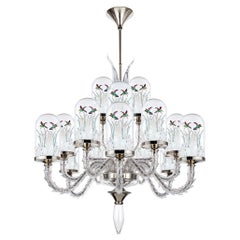De La Spada
Recent Sales
Artistic Handmade Chandelier Jardin De Verre, by A. La Spada and La Murrina
By La Murrina, Alessandro La Spada
Located in saronno, IT
The Jardin de Verre collection by Alessandro La Spada, a love story between man and nature, the
Category
2010s Italian Modern Chandeliers and Pendants
Materials
Blown Glass, Murano Glass
Artistic Handmade Chandelier Jardin De Verre, by A. La Spada and La Murrina
By La Murrina, Alessandro La Spada
Located in saronno, IT
The Jardin de Verre collection by Alessandro La Spada, a love story between man and nature, the
Category
2010s Italian Modern Chandeliers and Pendants
Materials
Blown Glass, Murano Glass
Artistic Handmade Chandelier Jardin De Verre, by A. La Spada and La Murrina
By La Murrina, Alessandro La Spada
Located in saronno, IT
The Jardin de Verre collection by Alessandro La Spada, a love story between man and nature, the
Category
2010s Italian Modern Chandeliers and Pendants
Materials
Blown Glass, Murano Glass
Artistic Handmade Chandelier Jardin De Verre, by A. La Spada and La Murrina
By La Murrina, Alessandro La Spada
Located in saronno, IT
The Jardin de Verre collection by Alessandro La Spada, a love story between man and nature, the
Category
2010s Italian Modern Chandeliers and Pendants
Materials
Blown Glass, Murano Glass
Artistic Handmade Chandelier Jardin De Verre, by A. La Spada and La Murrina
By La Murrina, Alessandro La Spada
Located in saronno, IT
The Jardin de Verre collection by Alessandro La Spada, a love story between man and nature, the
Category
2010s Italian Modern Chandeliers and Pendants
Materials
Blown Glass, Murano Glass
Artistic Handmade Chandelier Jardin De Verre, by A. La Spada and La Murrina
By La Murrina, Alessandro La Spada
Located in saronno, IT
The Jardin de Verre collection by Alessandro La Spada, a love story between man and nature, the
Category
2010s Italian Modern Chandeliers and Pendants
Materials
Blown Glass, Murano Glass
Artistic Handmade Chandelier Jardin De Verre, by A. La Spada and La Murrina
By La Murrina, Alessandro La Spada
Located in saronno, IT
The Jardin de Verre collection by Alessandro La Spada, a love story between man and nature, the
Category
2010s Italian Modern Chandeliers and Pendants
Materials
Blown Glass, Murano Glass
Artistic Handmade Chandelier Jardin De Verre, by A. La Spada and La Murrina
By La Murrina, Alessandro La Spada
Located in saronno, IT
The Jardin de Verre collection by Alessandro La Spada, a love story between man and nature, the
Category
2010s Italian Modern Chandeliers and Pendants
Materials
Blown Glass, Murano Glass
Artistic Handmade Chandelier Jardin De Verre, by A. La Spada and La Murrina
By La Murrina, Alessandro La Spada
Located in saronno, IT
The Jardin de Verre collection by Alessandro La Spada, a love story between man and nature, the
Category
2010s Italian Modern Chandeliers and Pendants
Materials
Blown Glass, Murano Glass
Artistic Handmade Wall Lamp Jardin De Verre, by A. La Spada and La Murrina
By La Murrina, Alessandro La Spada
Located in saronno, IT
The Jardin de Verre collection by Alessandro La Spada, a love story between man and nature, the
Category
2010s Italian Modern Wall Lights and Sconces
Materials
Blown Glass, Murano Glass
Artistic Handmade Wall Lamp Jardin De Verre, by A. La Spada and La Murrina
By La Murrina, Alessandro La Spada
Located in saronno, IT
The Jardin de Verre collection by Alessandro La Spada, a love story between man and nature, the
Category
2010s Italian Modern Wall Lights and Sconces
Materials
Blown Glass, Murano Glass
Artistic Handmade Table Lamp Jardin De Verre, by A. La Spada and La Murrina
By La Murrina, Alessandro La Spada
Located in saronno, IT
The Jardin de Verre collection by Alessandro La Spada, a love story between man and nature, the
Category
2010s Italian Modern Table Lamps
Materials
Blown Glass, Murano Glass
Get Updated with New Arrivals
Save "De La Spada", and we’ll notify you when there are new listings in this category.
De La Spada For Sale on 1stDibs
Choose from an assortment of styles, material and more with respect to the de la spada you’re looking for at 1stDibs. A de la spada — often made from blown glass, glass and murano glass — can elevate any home. When you’re browsing for the right de la spada, those designed in Modern styles are of considerable interest.
How Much is a De La Spada?
The average selling price for a de la spada at 1stDibs is $19,296, while they’re typically $2,111 on the low end and $54,823 for the highest priced.
Questions About De La Spada
- Who is Oscar de la Renta?1 Answer1stDibs ExpertApril 5, 2022Oscar de la Renta was a well-known fashion designer who became internationally renowned in the 1960s for being one of Jacqueline Kennedy’s designers. His full name is Oscar Aristides Ortiz de la Renta and he was born in 1932 in Santo Domingo, Dominican Republic. De la Renta passed away in 2014 after firmly establishing his clothing line as highly desirable and luxe with both couture and ready-to-wear options. Find vintage and contemporary Oscar de la Renta items from some of the world’s top boutiques on 1stDibs.
- 1stDibs ExpertApril 5, 2022Oscar de la Renta clothing is manufactured all over Europe as a symbol of elegance and romance. High-quality tailoring and forward fashion are marks of de la Renta clothes made for any occasion. On 1stDibs, you'll find authentic Oscars de la Renta pieces from top sellers worldwide.
- 1stDibs ExpertApril 5, 2022Oscar de la Renta is a well-known luxury brand of clothing, accessories, shoes and fragrances. There even was a housewares line unveiled in 2002 that included furniture. While not what the brand is noted for, de la Renta even designed a boutique hotel in 2006. Despite the broad reach, this brand is famous for haute couture and ready-to-wear clothing and accessories. You’ll find a variety of Oscar de la Renta products from some of the world’s top sellers on 1stDibs.
- Who has worn Oscar de la Renta?1 Answer1stDibs ExpertApril 5, 2024Many famous people have worn Oscar de la Renta. The brand is a favorite among First Ladies of the United States, with Jackie Kennedy Onassis, Nancy Reagan, Hilary Clinton, Laura Bush, Michelle Obama, Melania Trump and Jill Biden all having worn Oscar de la Renta dresses for public events. Other celebrities who have been photographed in Oscar de la Renta include Emma Watson, Taylor Swift, Sarah Jessica Parker, Penélope Cruz, Jessica Chastain, Tina Fey, Oprah Winfrey, Anne Hathaway and Zooey Deschanel. Human rights attorney Amal Alamuddin wore a dress by the French luxury fashion house when she married actor George Clooney in 2014. On 1stDibs, shop a collection of Oscar de la Renta apparel.
- 1stDibs ExpertApril 5, 2022The co-creative directors of Oscar de la Renta are Laura Kim and Fernando Garcia. This creative-directing duo were named to the position in 2016 after the departure of Peter Copping, who was appointed creative director after de la Renta’s death in 2014. On 1stDibs, you'll find authentic Oscars de la Renta pieces from top sellers worldwide.
- 1stDibs ExpertApril 5, 2022You can purchase Oscar de la Renta sunglasses from the brand’s website. You may also find new and vintage sunglasses at boutiques or online shops. With his classic design elements, Oscar de la Renta sunglasses make any style look fresh and modern — with a twist of elegance that only he can provide. Shop authentic Oscar de la Renta sunglasses on 1stDibs.
- Does Oscar de la Renta sell fur?1 Answer1stDibs ExpertApril 5, 2022No, Oscar de la Renta has been fur-free since 2021. However, examples of genuine fur clothing from Oscar de la Renta are still available on the used market, including on 1stDibs. You’ll find a collection of vintage and modern Oscar de la Renta fur from some of the world’s top sellers on 1stDibs.
- 1stDibs ExpertApril 5, 2022Yes, the Oscar de la Renta brand has created menswear. In fact, their men’s suits are well-known for their comfort and luxury, making them highly desirable. In addition to making suits, de la Renta has made a wide variety of menswear clothing. Find vintage and contemporary Oscar de la Renta clothing from some of the world’s top boutiques on 1stDibs.
- 1stDibs ExpertApril 5, 2022Some people report that their Oscar de la Renta shoes run small and others report that they are true to size. Your best option is to try on Oscar de la Renta shoes before purchasing to make sure they are a comfortable fit. You’ll find a variety of Oscar de la Renta shoes from some of the world’s top sellers on 1stDibs.
- 1stDibs ExpertApril 5, 2022The designer Oscar de la Renta made his international debut in 1965 with his own ready-to-wear line. de la Renta was one of Jacqueline Kennedy's couturiers, and he worked with brands like Balmain and Harrods. On 1stDibs, you can find vintage or modern Oscar de la Renta pieces from top sellers worldwide.
- 1stDibs ExpertApril 5, 2022Oscar de la Renta is best known for dressing celebrities and famous women in high-end luxury gowns and suits. The brand is also very well known for their wedding dresses. While those garments garner a lot of interest, Oscar de la Renta also has a well-known ready-to-wear line of clothing for men and women that has a more accessible price point. You’ll find a variety of Oscar de la Renta products from some of the world’s top sellers on 1stDibs.
- 1stDibs ExpertApril 5, 2022You can buy an Oscar de la Renta men’s jacket from the brand’s official website or from other online boutiques and seller platforms. The late Oscar de la Renta's designs were synonymous with New York's fashion and social scenes — whether you're looking for vintage or modern Oscar de la Renta's men's jacket for a casual night out on the town or a black-tie event, you'll find authentic Oscar de la Renta pieces on 1stDibs.
More Ways To Browse
Ancient Greek Busts
Black Roman Bust
Antique Deity Statue
Antique Ark
Vivienne Westwood Gold
Cactus Table
Antique Egyptian Statues
Antique Greek Vase Prints
Butterfly Chandeliers
Ancient Roman Marble Statues
Cactus Lamp
Chinese Shawls
Murano Bell Pendant
Vivienne W
Butterfly Wall Sconce
Antique Copper Statue
Bust Greek Apollo
Butterfly Cup

